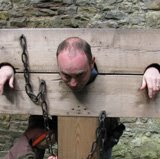I've been extending the MOLA publications database lately so that it now includes archaeological sites to which the publications relate. For pretty much all of these we have decent geographical point data (as we should, having dug most of them) and of course this is great for playing around with the data. So I've got a KML output going for that web API, which returns placemarks for sites corresponding to publications returned by your query. In the placemark are links to all the publications related to the site. You can also go the other way round: either query by the publication's ID to get its details and (in KML mode) related sites; or query by site, which returns simple XML for each related publication or, if you choose KML, returns all points related to books linked to that site (potentially lots of points, not just the one in your query). What it all means is that you can see your search results in Google Earth or on a map if you like by pasting in the URL for the KML e.g. http://www.museumoflondon.org.uk/museumoflondon/food/rest.aspx?source=pubs&mode=kml&period=roman
So far I've not put this into the public interface because I think to do so requires some consideration, but this will come. I'm pleased in part because I can start to use this API in my own behind-the-scenes integration. For example I've also just done a load of work on the site summaries that we publish for all the work that MOLA does. The KML for these is cleaned up and the old ASP/XSLT thing I did to search across these (and other reports) by borough has been refreshed. It now lets you search by site code, and now that I can get at publications via site code it's a pretty small step to get it also to return related publications, which should come very soon (perhaps before going-home time). Because they're in very different data sources (XML files and SQL Server) it wasn't so straight forward before, now it is. The publications API is mainly for internal consumption like this (it also runs the user-facing publications page itself, at a lower level). I'd be really pleased, though, if others find a use for this, and any thoughts about the rights and wrongs of how I've done it would be gratefully received.

No comments:
Post a Comment